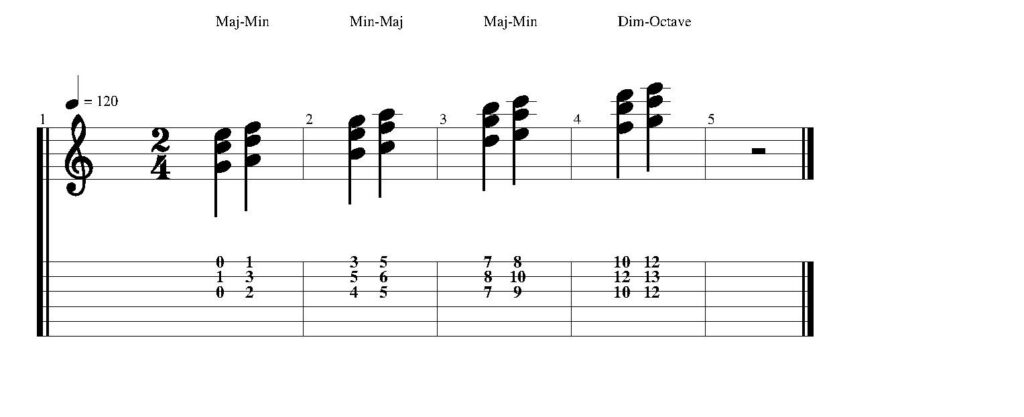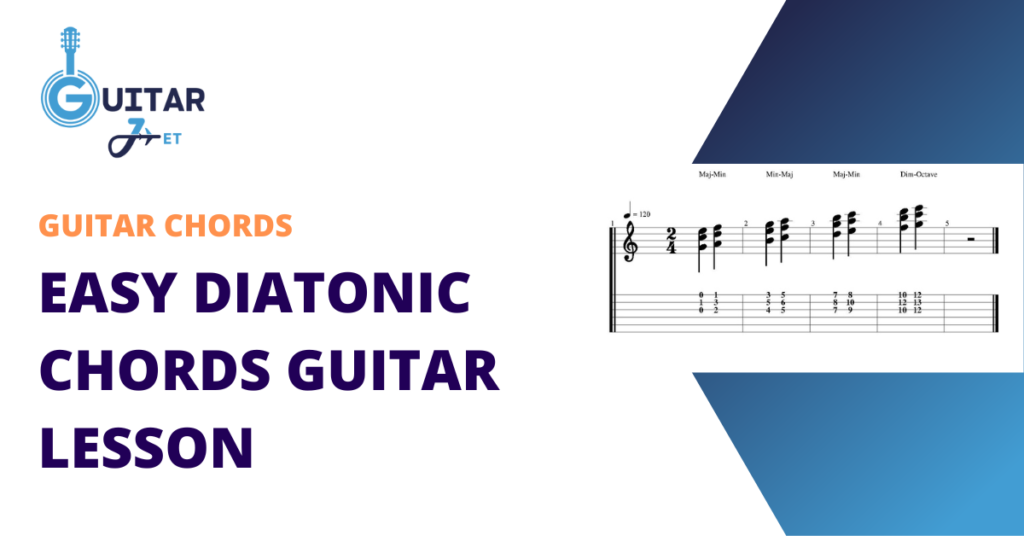Today, you’ll look at a complete, easy diatonic chords guitar lesson.
You’ll learn the fundamentals, and you’ll get to play an easy diatonic exercise.
By the end of this, you’ll know what diatonic chords are, how they’re constructed, and how to apply them to chord progressions!
Let’s dive in and play!
Table of Contents
Diatonic chord definition
To start, we need to define the word diatonic. Diatonic simply means “from the scale”.
Diatonic chords refer to chords from a particular scale, which means chords you can construct and harmonize using the notes from the scale.
Harmonizing the major scale
The easiest way to understand this is by looking at the diatonic chords in the C major scale, the most common scale in Western Harmony.
First, let’s look at the notes in the C major scale:
C-D-E-F-G-A-B
Now we need to harmonize these notes by turning each degree of the C major scale into a triad, which is a chord with 3 notes.
To build a triad from each degree, you’ll stack the notes in thirds. Put simply, this means stacking every other note.
For example, your first note is the note “C”, and to turn it into the C major triad, you’ll stack notes in “thirds”, which gives you the notes C, E, and G.
You’ll do this for each degree of the scale. Harmonizing this way will give you the diatonic chords in the scale.
Diatonic triads in order
The good news is, every major scale has the exact same order of diatonic chords!
Diatonic triads in order are:
- Major
- Minor
- Minor
- Major
- Major
- Minor
- Diminished
In the C major scale, this gives you the diatonic triads:
- C major
- D Minor
- E Minor
- F major
- G major
- A minor
- B diminished
Here are the notes in each chord:
| C Major | C | E | G |
| D Minor | D | F | A |
| E Minor | E | G | B |
| F Major | F | A | C |
| G Major | G | B | D |
| A Minor | A | C | E |
| B Diminished | B | D | F |
Roman Numerals in Diatonic Harmony
Each diatonic chord is given a number in order, from 1-7, to understand where it lies in the diatonic scale.
The numbers are depicted with Roman numerals.
For major chords, the numeral is capitalized. For example, “I”.
For minor chords, the numeral is lowercased. For example, “i”.
Example Chord Progression
In a 1-4-5 major chord progression, the capitalized numerals are: I-IV-V
In the key of C major, this gives you the chords:
I– C Major
IV– F Major
V– G Major
Now, if you want to add a minor chord to the progression, you’ll make it lowercase. For example, let’s add the minor 6th. We’ll use the progression: I-vi-IV-V
This gives you the chords:
I– C Major
vi– A Minor
IV– F Major
V– G Major
The minor chord uses 2 lowercase letters, small “v” and a small “i”, which create the minor 6th numeral when combined. The lowercase letters help you distinguish the minor numeral from the capitalized, major numerals in the progression.
Playing Diatonic Chords
Let’s end this by looking at some common ways to play diatonic chords on the guitar. We’ll stick with the diatonic chords in C major.
In order, this gives you:
Cmaj – Dmin – Emin – Fmaj – Gmaj – Amin –Bdim
In the example below, each chord’s root note is on the B string.


